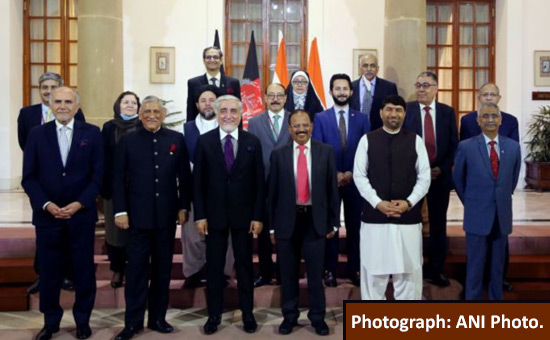- Good to see Gen Naravane visiting Mynamar with Foreign Secretary. The future can only
get better if we continue to break silos across government department and work
as integrated teams focussed on promoting national interests.
The political events of the last few
weeks have overshadowed two key developments.
One is the visit
to Mynamar of Army Chief General Manoj Mukund Naravane and
Foreign Secretary Harsh Vardhan Shringla.
Two is National Security Advisor Ajit Doval's meeting with Dr Abdullah Abdullah, chairman of the high council on national reconciliation of Afghanistan (and the chief negotiator with the Taliban).
It was also attended by Chief of Defence Staff General Bipin Rawat, General Naravane, Deputy NSA Pankaj Saran, military adviser to the National Security Council Secretariat, Lieutenant General V G Khandare, among the NSA's delegation members.
The composition of India's delegation to these meetings was unique and indicates a new thinking.
Take the meeting
with Myanmar, where having the army chief present with the foreign secretary
was truly a remarkable development.
Power in Myanmar is shared between the
elected government and the army. Some 25% of the MPs are from the army. So any
government to government meetings must also include a general as an Indian
representative, because two army men would be more comfortable talking to each
other and naturally so.
In the past India always had problems
because our defence ministry officers did not integrate well with the military
and we were compelled to deal with Myanmar not in an integrated manner.
For once, we are dealing in an
integrated way on security, international and economic issues.
The challenges in Myanmar are both political and military. We both face similar problems with separatist groups. Myanmar assists India in dealing with north east separatist groups that seek refuge there, like the NSCN (Khaplang)
For Myanmar their separatist groups cross the borders and take refuge in China's Yunan province.
Again, two men in uniform, facing a
similar problem, will relate to each other better than, say, a babu and
a general.
 Afghan dignitary flanked by India’s NSA, CDS, Army Chief etc.
Afghan dignitary flanked by India’s NSA, CDS, Army Chief etc.
Full
caption - Dr Abdullah Abdullah, chairman of Afghanistan's high council for national reconciliation, front, centre, flanked by India's National Security Advisor Ajit Doval to his left and Chief of the Defence Staff General Bipin Rawat to his right, along with other Indian and Afghan officials at Hyderabad House, October 14, 2020.
The second meeting was even more
interesting.
From Afghanistan it had Dr Abdullah, and from India many members of the national security secretariat, the CDS and army chief. Such composition from the Indian side was unheard of earlier.
Is the army chief's involvement an indication that the government wants to now involve the armed forces in the national security decision-making structure?
Is the involvement of the CDS and army
chief an indication that India might move men into Afghanistan after the US
troop numbers are reduced in November?
Is the involvement of the CDS and army
chief an indication that India
might move men into Afghanistan after the US troop numbers are reduced in November?
While it is part of speculation, were it to happen it would disturb China's brother in arms on our western border.
As part of the deal to place Indian troops in Afghanistan in a peace-keeping role, if Indian
troops are also placed in the Wakhan Corridor (a wedge between Pakistan and
Tajikistan) they might be close to the Karakoram highway (that links Kashgar in Xinjiang to Islamabad).
What these two
meetings indicate is the breaking of silos between government departments. In
corporate jargon, this represents the formation of cross-functional teams to
solve problems.
I am surprised these moves have not got
the appropriate attention. It would be interesting to know who is behind this
innovative thinking.
Further, due to the preoccupation with the Ladakh standoff, the existence of the chief of defence staff has gone unnoticed.
It took 72 years for India to have a
CDS. He is to be the single point military advisor to the defence minister and
heads the department of military affairs.
This department would promote
jointness in procurement, training and staffing for the three services through
joint planning and integration of their requirements.
We have seen some of this during the Ladakh stand-off when the the Indian Navy's MiG29K were pressed into service.
The department has an additional
secretary, joint secretaries and deputy/under secretaries. While it is
premature to comment on the success or failure of the CDS position, what is
important is that many babus now report to a former army chief.
Cynics might see this as limited
progress but consider that it took India 72 years to even get here.
The future can only get better if we
continue to break silos and work as integrated teams focussed on promoting
national interests.
Also note that India has launched six missile system tests in the month gone by (HSTDV, LGATGM, Shaurya, SMART, Rudram-1, Brahmos ER), a clear message to India's friends. Their timing are part of India's psychological warfare.
After all, today's wars are also economic and psychological. Having said that, India has not used these tools of warfare extensively in the past. This shows that India is now taking an integrated approach to national security.
Irrespective of the outcome in the
Ladakh stand-off, an integrated approach to national security is the way to go.
First published in Rediff.com and here
Post writing article Indian Army Chief to visit Nepal according to this article
in the Kathmandu Post. The deeper aim is to revive the dialogue between
countries although army chief is going to be decorated as Hon Gen of Nepal Army
per tradition.